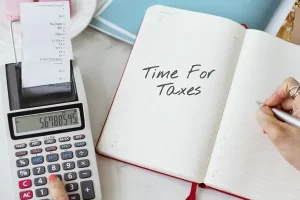
The Power of the Profit and Loss Report
December 1, 2023
How to Keep Your Rental Property Profitable During Rising Interest Rates and Market Uncertainty
January 23, 2024
The Power of the Profit and Loss Report
December 1, 2023
How to Keep Your Rental Property Profitable During Rising Interest Rates and Market Uncertainty
January 23, 2024 GST for New Zealand Businesses: A Comprehensive Guide
GST for New Zealand Businesses: A Comprehensive Guide
Navigating the Rules: Understanding GST in New Zealand can be daunting. This GST Guide for Businesses will help demystify the process, ensuring compliance and smooth operations.
If you run a business in New Zealand, understanding GST (Goods and Services Tax) is essential to your success. This tax is added to the price of most goods and services in New Zealand, including most imported goods and some imported services. Currently set at 15%, GST affects nearly every business transaction you’ll make. In this comprehensive guide, we’ll walk you through the essential aspects of GST and provide valuable insights to help your New Zealand business stay compliant and optimize your tax position.
What is GST?
GST is a consumption tax that businesses collect on behalf of Inland Revenue. When you sell goods or services, you charge GST on top of your base price. You then pass this collected GST to the government, minus any GST you’ve paid on your business purchases. This system ensures that tax is collected at each stage of the supply chain, ultimately being paid by the end consumer.
Your Guide to Registering for GST
Understanding when and how to register for GST is crucial for every New Zealand business owner.
When Must You Register?
As a business owner, you must register for GST if:
- Your annual turnover (total sales) exceeds $60,000, or
- Your turnover is expected to exceed $60,000 in the next 12 months
Voluntary Registration
Even if your turnover is below the $60,000 threshold, you can choose to register voluntarily. This might benefit your business if you have significant GST expenses or want to present a more established image to clients.
Benefits of GST Registration
Once you’re registered for GST, you must charge GST on your sales. However, you can also claim GST on your business purchases if they include GST. This ability to claim GST back lowers your overall GST liability and can even create a GST refund if you make a large purchase, such as a vehicle or equipment.
A Guide to Understanding GST on Purchases
Do All Purchases Have GST?
No, not all purchases will include claimable GST. You cannot claim GST on payments made to businesses that aren’t GST registered. Additionally, certain costs don’t have GST included in them at all.
Common non-GST expenses include:
- Wages and salaries
- Bank fees
- Interest charges
- Loan payments
- Owners Drawings
It’s important to identify which expenses include GST so you can accurately claim back what you’re entitled to while maintaining proper records.
GST Filing Frequencies
How Often Do You Need to File GST Returns?
You can choose to file your GST returns on one of three schedules:
- Monthly – typically for larger businesses with high transaction volumes
- Two-monthly – a popular option for small to medium businesses
- Six-monthly – suitable for smaller businesses with lower turnover
As a guide most small businesses opt for two-monthly or six-monthly GST returns. Your chosen filing frequency affects how often you must pay or receive GST refunds, as well as how much administrative work is required to maintain compliance.
Your Guide to GST Accounting Basis Options
When you register for GST, you must choose an accounting basis that determines when you account for GST on your sales and purchases.
The Three Methods:
1. Payments Basis This method is based on when you actually receive or make payments. You only pay GST when you’ve received money from your customers and can only claim GST when you’ve paid your suppliers.
2. Invoice Basis This method is based on when you issue or receive invoices, regardless of when payment actually occurs. You must pay GST on sales as soon as you invoice them, even if your customer hasn’t paid yet.
3. Hybrid Method This combines elements of both the payments and invoice methods, though it’s less commonly used.
Should You Choose the Payments Basis?
The payments basis is the most common GST accounting method for small businesses, and with good reason. It’s usually best for cashflow because you only have to pay GST on your sales when you actually receive payment from your customers.
Under the invoice basis, you need to return GST on sales before you’ve received the money from your customer or client, which can create cashflow challenges.
Why Would Anyone Use the Invoice Basis?
There are two main scenarios where the invoice basis is used:
1. Mandatory Registration If your business turnover exceeds $2 million annually, you’re required by law to use the invoice basis. While this means you must pay GST on sales before receiving payment, you also get to claim GST expenses before you’ve actually paid them.
2. Strategic Advantage Some businesses with high upfront costs but longer payment terms may benefit from the invoice basis, as they can claim GST on expenses immediately while their customer payments are still outstanding.
New GST Invoicing Rules (Effective 1 April 2023)
Inland Revenue has modernized GST record-keeping requirements to provide businesses with more flexibility.
What Changed?
The new rules replace the strict requirement to use traditional tax invoices with a more general requirement to provide and keep certain records known as “taxable supply information.” These rules set out the minimum records required to support the figures in your GST returns.
Flexible Record-Keeping
You can now use any format or method to provide taxable supply information, provided it:
- Contains all the required information
- Is easily accessible by Inland Revenue
You can also use eInvoicing, which is a secure way of exchanging invoices electronically between businesses, offering improved efficiency and reduced administrative burden.
GST Record Keeping Guide
Proper record-keeping is not optional—it’s a legal requirement that protects your business during audits and ensures accurate GST reporting.
What You Must Keep:
- All invoices issued to customers
- All expense receipts from suppliers
- Records of adjustments for business, private, and exempt use of goods and services
- Retention period: Seven years from the end of the tax year
Failing to maintain adequate records can result in penalties and make it difficult to defend your GST position if questioned by Inland Revenue.
Managing GST with Xero
Xero is a cloud-based accounting software that simplifies GST management for New Zealand businesses.
How Xero Helps:
- Automatic Calculations: Xero calculates GST for each transaction line individually, based on the tax rate you select
- GST Return Generation: The system automatically generates your GST returns based on your chosen accounting basis and filing frequency
- Review and Edit: You can review and edit your returns before submitting them online directly to Inland Revenue
- Real-time Tracking: Monitor your GST position at any time to avoid surprises
This automation reduces errors, saves time, and provides peace of mind that your GST obligations are being met correctly.
Learn more: Is Xero Right for My Business?
Essential GST Calculations
Understanding how to calculate GST is fundamental to pricing your products and services correctly.
GST Inclusive vs. GST Exclusive
In business, we work with two types of amounts:
- GST exclusive – the amount without GST
- GST inclusive – the amount with GST included
How to Add GST to an Amount
To add GST to a GST-exclusive amount, multiply by 1.15.
Example: If your base price is $100, the GST-inclusive price is: $100 × 1.15 = $115
Alternative method – Calculate the GST portion separately by multiplying by 0.15: $100 × 0.15 = $15 GST $100 + $15 = $115 GST-inclusive price
How to Find the GST Amount in a Price
To find just the GST component of a GST-inclusive price, multiply by 3 and divide by 23.
Example: If the GST-inclusive price is $115, the GST portion is: $115 × 3/23 = $15
How to Find the GST Exclusive Price
To remove GST from a GST-inclusive price, divide by 1.15.
Example: If the GST-inclusive price is $115, the GST-exclusive price is: $115 ÷ 1.15 = $100
Common GST Pitfalls to Avoid
- Missing the registration deadline – Register before you exceed the $60,000 threshold
- Incorrect accounting basis – Choose the method that suits your business cashflow
- Poor record-keeping – Maintain organized records from day one
- Claiming non-claimable GST – Understand which expenses have GST
- Late filing – Submit returns on time to avoid penalties
Frequently Asked Questions (FAQ)
Q: What happens if I don’t register for GST when I should? A: If you exceed the $60,000 threshold without registering, you may face penalties and interest charges from Inland Revenue. You’ll also be required to pay GST on your sales from the date you should have registered, without being able to charge it to your customers.
Q: Can I change my GST filing frequency after I’ve registered? A: Yes, you can apply to Inland Revenue to change your filing frequency. However, you must meet certain criteria and provide business reasons for the change.
Q: What if I make a mistake on my GST return? A: If you discover an error, you should correct it as soon as possible. For recent returns, you can make adjustments in your next return. For older returns, you may need to file an amendment with Inland Revenue.
Learn more: Mastering GST: 10 Common Mistakes NZ Businesses Make
Q: Do I charge GST on sales to overseas customers? A: Generally, goods and services exported from New Zealand are zero-rated for GST, meaning you don’t charge GST but can still claim GST on related expenses. However, specific rules apply depending on the nature of the supply.
Q: Can I claim GST on vehicle purchases? A: Yes, if the vehicle is used for business purposes and purchased from a GST-registered seller, you can claim the GST. However, if there’s private use, you may need to make adjustments. If you are a company, there may be Fringe Benefit implications.
Learn more: Is Your Ute Really Exempt from FBT? What Business Owners Need to Know
Q: What’s the difference between zero-rated and exempt supplies? A: Zero-rated supplies have a GST rate of 0% (you don’t charge GST but can claim GST on expenses), while exempt supplies are outside the GST system entirely (you don’t charge GST and can’t claim GST on related expenses).
Learn more: Understanding the Difference: GST Exempt vs Zero rated GST
Q: How long does it take to receive a GST refund? A: If you file electronically and have no outstanding tax obligations, Inland Revenue typically processes refunds within 15 working days.
Q: What records do I need to support my GST claims? A: You need taxable supply information that includes the supplier’s name, date of supply, description of goods or services, amount charged, and GST amount. This can be in any format as long as it’s easily accessible.
Q: How much do you charge for GST returns? A: Review and filing of your GSt return from Xero starts from $95+GST. Complete reconciliation of your Xero, review and filing of the GST return starts from $210+GST.
Summary – Your Guide to GST in New Zealand
GST is an essential part of doing business in New Zealand, but it doesn’t have to be overwhelming. Understanding when to register, which accounting basis to choose, how to maintain proper records, and how to calculate GST correctly will help your business remain compliant while optimizing your tax position.
The key takeaways are:
- Register when your turnover reaches or is expected to reach $60,000
- Choose the accounting basis that best suits your cashflow
- Maintain detailed records for seven years
- File your returns on time according to your chosen frequency
- Use accounting software like Xero to simplify GST management
- Understand which expenses include claimable GST
While tax can be complex and confusing, getting expert guidance ensures you meet your obligations while maximizing your business’s financial position.
Get Advice from an Expert GST Guide Today
Don’t navigate GST compliance alone. Whether you’re just starting out and wondering if you should register, need help choosing the right accounting basis, or want to ensure your current GST processes are optimized, the team at Business Like NZ Ltd is here to help. We hope you found this GST Guide useful!
As experienced Chartered Accountants serving South Auckland and beyond for years, we understand the unique challenges New Zealand businesses face with GST compliance. We can provide personalized advice tailored to your specific business situation.
Contact Us Today:
Phone: 09 262 0726
Address: 116e Cavendish Drive, Manukau City Centre, Auckland 2104, New Zealand
Free, No-Obligation Consultation
We offer a free initial consultation to discuss your GST needs and show you how we can help your business. This single conversation could change the direction of your business by ensuring you’re GST-compliant while maximizing your tax efficiency.
Book your free chat today by calling 09 262 0726 or visit our website to get a quote.
For more general information on GST, you can also visit the Inland Revenue website. However, for specific advice tailored to your business circumstances, contact our expert team.
Stay informed: Sign up to our once-a-month newsletter to receive valuable tax tips, business insights, and updates on regulatory changes that affect your business.
Don’t leave your GST compliance to chance—contact Business Like NZ Ltd today and ensure your business is on the right track.
Learn more: How Easy Is It to Switch Accountants? A Simple 2-Step Guide for Kiwi Businesses
